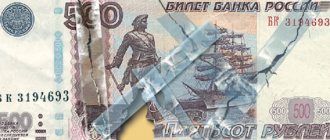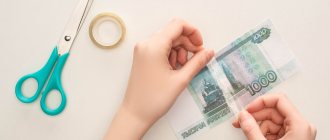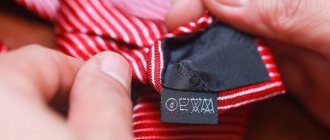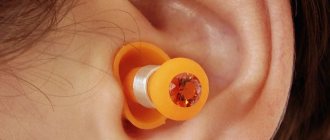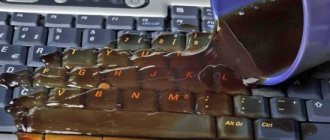What to do with a torn banknote - can it be exchanged at a bank and how to do it correctly. Are shops required to accept torn banknotes?
Paper money tends to wear out and lose strength. Stores often refuse to accept torn bills. The problem becomes especially urgent if a banknote with a denomination of 500 rubles or more has been damaged.
The article will tell you whether torn banknotes are valid, how the degree of damage is determined and how to change a torn bill at Sberbank.
Are stores required to accept torn money?
Banknotes with minor damage are accepted for circulation if it is possible to determine their denomination and authenticity. Stores are required to accept them. The refusing party violates two articles of the Civil Code of the Russian Federation at once - 426 and 445. Unfortunately, in this case no liability is provided. In addition, sellers often refuse to accept such banknotes because they cannot be used in commodity-money transactions. They are required to hand them over along with the proceeds for subsequent exchange.
Stores must accept money if:
- the banknote is missing an edge or corners;
- banknotes have become discolored as a result of washing or prolonged storage in the sun;
- banknotes have stamps, drawings or impressions that do not interfere with identification and determination of their authenticity;
- The Bank of Russia ticket has small punctures, traces of dirt, and greasy stains.
If the buyer is given damaged money at the checkout, he has the right to demand that it be replaced with intact money.
What does the law say about torn banknotes?
According to the instructions of the Bank of Russia “On the signs of solvency and the rules for the exchange of banknotes and coins of the Bank of Russia” dated December 26, 2006, banknotes with minor defects are considered solvent:
- with lost edges, corners;
- dirty, with tears or signs of wear;
- with abrasions, stains, inscriptions, minor punctures.
The nuances of exchanging damaged dollars and euros
Regarding the exchange of damaged currencies, the Central Bank did not issue any resolutions or instructions. Accordingly, the exchange process is regulated exclusively by the bank where the applicant applied. The bank may refuse to exchange the banknote if it appears to be significantly damaged. In addition, many Russian banks simply do not offer services specifically for exchanging a torn foreign banknote for a whole one.
Therefore, a bank employee can offer several options:
- Replace foreign currency with Russian rubles;
- Credit money to your current or deposit account after converting currencies in accordance with the current exchange rate;
- The so-called "collection". Money for collection is sent to the country where the banknote was issued. The process can take years, and you still have to pay a fee for using the service.
Please note that all transactions are carried out with a commission - usually 3-12% of the face value of the foreign currency. If the bill is severely damaged, the bank may impose an increased commission or refuse service altogether.
Is it possible to exchange a torn banknote at a bank?
Banknotes with the following defects are subject to exchange:
- with a loss of no more than 45% of the total area;
- glued together from several fragments belonging to one banknote;
- glued together from two fragments of different banknotes of the same denomination;
- defective;
- exposed to fire or aggressive environments, if the banknote can be identified by denomination and authenticity;
- Due to damage, the serial number of the banknote is not readable.
To exchange money, the client will need a passport.
This is interesting:
How to correct your credit history at Sberbank: detailed instructions
Credit history in Sberbank - how to find out online yourself
What difficulties may arise
If the torn money meets all the requirements, there will be no difficulties with the exchange. In some cases, when a bank employee has doubts about the authenticity of a banknote or its condition is extremely unsatisfactory, the money will be sent for examination. If the banknote has been withdrawn from circulation, the bank has the right to refuse exchange.
Important! The banknote exchange service is free for the population.
Will I be charged a commission for the exchange?
There is no fee for replacing national currency. Any attempt on the part of the bank to take money for this service is punishable by law. Until 2010, the cost of the examination was borne by the applicant, but now, if the applicant exchanges Russian rubles, the procedure is absolutely free. In addition, since 2014, the requirement for mandatory examination before exchanging a banknote has been discontinued.
If, when exchanging money or ordering an examination, a bank employee demands to pay a commission in advance (or upon the provision of services), you can file a complaint against him with the Central Bank of the Russian Federation or the bank management. You will have the right to do this, since charging a commission in this case is an illegal action.
Which banks accept problem banknotes?
According to the law, damaged rubles are required to be exchanged by all banking organizations in Russia. The process does not imply any commissions for the population. If the bank refuses to exchange or requires payment of a commission for the operation, you can safely write a complaint to the Central Bank. Sberbank of Russia is most loyal to replacing damaged funds.
Exchange may be refused in the following cases:
- more than 55% of the banknote area has been lost;
- the banknote is glued together from many small pieces;
- part of the glued bill is less than 50%;
- banknotes are marked with paint to prevent theft;
- in case of delamination and loss of one of the layers;
- banknote – sample or counterfeit.
The exchange of old banknotes has no limit on the amount.
Important! If a counterfeit banknote is detected, a report will be drawn up stating that it is dubious or a stamp will be affixed indicating a refusal to exchange.
Examination of damaged banknotes
If a bank employee, when exchanging defective banknotes, has doubts about the authenticity of the banknote or it has significant damage, the money is sent to the settlement center for examination. The client writes a statement indicating the condition of the transferred banknotes. The cashier takes a copy of the application and certifies it with a signature and stamp. The certified copy and order remain with the client.
The examination lasts from 5 to 10 working days. If she has confirmed the authenticity of the banknote, funds can be received in cash or to a bank card. Otherwise, the bill will be returned with the appropriate stamp.
The bank has the right to send a banknote for examination if:
- it is torn into 4 parts;
- glued together from 10 or more pieces;
- from different banknotes of the same denomination.
Which banks accept old dollars?
Old dollars must also be replaced in all Russian banks. The rules for the exchange of defective banknotes are regulated by the bank itself. Dollars are exchanged with a commission, the amount of which is set by the banking organization. When contacting a bank with torn or dilapidated dollars, the client may receive an offer to purchase currency, transfer money to an account, or send it for collection.
Important! Applying for collection does not guarantee the exchange of banknotes even after paying a commission.
What to do with a torn euro bill
Replacing torn or damaged euros is the same as exchanging dollars that have become unusable. However, the commission for exchanging them in banks is usually higher.
When exchanging old euros at the cash desk, the bank does not have the right to set its own rate for them - the currency is exchanged at the current rate. It is prohibited to introduce restrictions on the denomination and year of issue of the currency, as well as on the amount of worn-out currency.
Is it possible to sell a banknote if it is torn?
No one will punish anyone for trying to sell a damaged paper banknote by paying for the goods. Often sellers and service providers accept such money without talking, because they know that they can replace it without any problems. It is clear to everyone that before money is taken out of circulation due to disrepair, it will function for some time, falling into the hands of buyers and sellers.
If the banknote is not torn in two, but only torn on one side, it must be carefully glued with tape. When calculating, it is best to sell it first by making a purchase in a hypermarket, where there is a large turnover of money. Or you can:
- pay with it through the terminal;
- put it on a bank card.
In these cases, the money will go to the bank, where it will be immediately replaced.
My friend Anton acted differently: he put the torn bill in his wallet, and when paying, he did not use it for a long time, because, in his words, “it was inconvenient for him.” After some time, the paper money tore in two, and then Anton forgot about the inconvenience and called me.
What to do if an ATM dispenses a torn bill
ATMs rarely accept torn or glued money, however, errors and technical glitches are possible with any technology. If a client receives a damaged banknote from an ATM, it is recommended to contact the bank to exchange it. The algorithm of actions in this case does not differ from replacing an ordinary torn banknote, but experts recommend taking a receipt from an ATM with you as documentary evidence.
This is interesting:
3 blatant ways people are being scammed at ATMs
Will the ATM accept taped and torn bills?
Banks accept both glued and torn money, provided that the area is maintained at least 55%. But, this is an official institution where the exchange of banknotes will be carried out by living people.
Another question: does the ATM accept bills glued with tape, because with modern technologies everything becomes simpler and more complicated at the same time. Since ATMs read data not visually, but sensory, and they are not designed to accept money whose integrity has been compromised. This is due to the fact that machine sensors cannot correctly read the watermark, serial number and denomination of paper money.
However, 60% of ATMs will accept banknotes neatly glued together with thin tape only if the device can freely read all the designations and easily identify the denomination and authenticity of the monetary unit.
How to seal a torn banknote yourself and is it worth doing?
Experts recommend that you immediately return the torn banknote to the bank for exchange. The procedure is simple and does not require financial costs on the part of the client. However, not everyone agrees to spend time on this.
Many people cover a torn banknote with tape, but this looks rude and not aesthetically pleasing. Such money may not be accepted in stores, and self-service terminals will “spit” it back. You can glue a torn banknote in several ways, for example, with PVA glue.
To do this you will need:
- glass bottle, jar or wax paper;
- PVA glue;
- iron.
What to do if a banknote is torn:
- A thin layer of glue is applied to the tear site. This can be done using a toothpick, knitting needle or match.
- The halves of the banknote are placed end-to-end on a bottle or paper, matching the pattern. There should be no overlap when joining.
- A hot iron is passed over the joint several times and allowed to cool.
You can also glue a damaged banknote using a glue stick:
- To do this, apply glue along the ends, let it dry and apply it again.
- Then the torn parts are placed on wax paper, carefully adjusting the design.
- Talc or starch is applied to the joint to avoid gluing with other bills.
- The banknote is allowed to dry for half an hour.
Office supply stores also sell special adhesive tape for repairing damaged money. Unlike ordinary stationery tape, it is invisible after gluing.
Frequently asked questions and their answers
Will the ATM accept a torn bill?
If the bill is carefully sealed, then about 60% of ATMs and terminals can accept it.
Banknotes taped together may not be accepted at self-service machines.
How to seal a torn banknote yourself?
There are several options for gluing money:
- A thin strip of transparent tape on one or both sides;
- A neat strip of papyrus or tracing paper;
- Use regular/quick-drying glue so that the seam is barely noticeable (if the denomination is large, it’s better not to risk it).
Foreign currency issues
If Russian rubles are exchanged without any problems (of course, subject to the above conditions), then problems may arise with foreign currency. And you will encounter the first of them when you are informed about the commission. It can be up to 10% of the amount exchanged. Why so much? Everything is explained easily and simply. Often, an examination that determines the authenticity of a banknote is carried out at the manufacturer’s bank at its expense. The process can take from one week to several months.
The next question will arise when you present the bill itself. If the bank takes dollars, euros and the currencies of nearby European countries, then banknotes from “distant” countries may simply not be available. Therefore, complaints about such a refusal will not be considered by the Central Bank.
And foreign currency requirements will be slightly tightened. Euros and dollars should retain 50% of their surface, Belarusian rubles and Ukrainian hryvnias – 45%.
In this regard, a low percentage of foreign currency exchange has been documented, both by Sberbank and other banks (both state and commercial).
Examination of damaged banknotes
An examination necessarily establishes the authenticity of banknotes.
When it is not possible to visually determine the condition of banknotes, a bank employee is obliged to send them for a special examination. This procedure is free and is carried out at territorial branches of the Bank of Russia.
To do this, it is necessary to draw up an application in two copies and an inventory of banknotes sent for examination.
You should still have a warrant and a second copy of the application in your hands, containing an imprint of the cash register stamp and the cashier’s signature. Banknotes are sent to the examination site within five working days, the procedure itself takes the same amount of time.
If these banknotes are recognized as genuine and a decision is made to replace them with new ones, you will receive them at the same bank, depending on the chosen method.
What documents are needed
According to legislative acts, domestic currency presented to the bank in the form of a torn banknote can be simply replaced. That is, the algorithm is as follows:
- a citizen approaches the cashier's window and hands over a damaged banknote>;
- The cashier accepts it and issues a banknote of the same denomination in return.
At the same time, he has no right to demand any documents, including a civil passport. There is also no need to write any statements or explanatory notes.
In the case of my friend Anton, this is what happened - the thousandth bill was replaced for him without talking.
How to use damaged money
Damaged banknotes can be used in the same way as regular ones. Such money will not be accepted only if it is damaged too much. Moreover, the signs of solvency of banknotes and coins are strictly designated by the Central Bank of Russia, which in 2006 issued special Instructions.
The following banknotes are accepted for all types of payments:
- Having small holes or punctures, with damaged edges and missing corners, tears;
- On which there are various inscriptions, stamp impressions;
- The appearance of which is spoiled by minor abrasions, dirt, small stains (from paint, oil, etc.);
- Faded (for example, after washing), provided that the image and number remain unchanged and are clearly visible.
The Central Bank divides all banknotes into three degrees of disrepair. Money that has the above characteristics belongs to the 1st degree of disrepair. Payment organizations may not accept 2nd and 3rd degree bills.
Thus, all of the above flaws are not a reason for refusing to pay with a damaged bill in a store or bank.
With ATMs things are worse. They do not accept banknotes with significant tears, even if they have been glued together. However, there is a chance that the ATM will simply accept slightly tattered bills - this depends on the settings of the reader.
✅ RECOMMENDED: Find out how and where to check money for authenticity
Exchange rules
Where can I change a torn banknote? Theoretically, damaged banknotes can be exchanged at any banks. But in practice, some commercial banks may refuse this, citing internal instructions or regulations. The best option for exchanging such money would be to contact Sberbank. There are no problems with how to change a torn banknote at Sberbank. There, banknotes are always changed without problems if they meet certain conditions.
When exchanging a worn-out banknote, the main thing is to have the banknote number and security features on it or a fragment.
Is it possible to change a torn banknote at Sberbank? Yes, the bank is obliged to do this if:
Banknote on top - more than 55% of the area is preserved, below - less than 55% of the area.
- At least 55% of its original area has been preserved. Damage can be of different types - you will be exchanged for burnt, torn, or exposed banknotes;
- It is glued together from fragments (their number can be any), provided that the area of the parts belonging to the same banknote is at least 55%;
- It is glued together from two halves of different bills of the same denomination. All parts must form a solid image, and the area of each must be at least 50% of the original bill;
- It changed color, but the image remained clearly visible;
- The defect is a manufacturing defect.
✅ RECOMMENDED: Tips on how to remember where you put your money and find your hidden stash
A banknote will not be exchanged if:
- Less than 55% of its original area remains;
- It is glued together from fragments constituting less than 55% of the area of the same bill;
- It delaminated and completely lost one of the sides;
- Special bank paint was applied to it;
- It has the word "sample" on it.
The exchange procedure does not require a passport, and if the cashier can immediately determine the degree of damage to the banknotes, he will issue new ones on the spot.
How not to do it
What actions should be avoided:
- When gluing banknotes, you should not rush; you must carefully adjust the torn parts to each other;
- The restored banknote cannot be left on a horizontal surface; it is better to dry it in a vertical position.
To avoid breaks, money should be carried in a wallet. You should also check banknotes for flaws without leaving the cash register.
Do I have to pay to replace a torn banknote?
If we are talking about replacing domestic currency, then the bank has no right to charge any interest for replacing money. The procedure is equal to other types of monetary transactions that are carried out free of charge. Accordingly, if a bank specialist demands that a visitor pay for replacing money, you need to immediately call the hall administrator and file a complaint.
Such rules apply to one banknote, which can be restored along the break line. The same applies to cases when only one part of the banknote is presented, and the second is lost. It must be accepted under the following conditions:
- if more than half of the bill is presented (more than 55%);
- when can you determine its dignity and number.
And if two fragments from different banknotes of the same denomination are provided, each of which has a size of at least 50%, then they will be accepted as one banknote. That is, for both fragments you can get only one bill of the same denomination.
